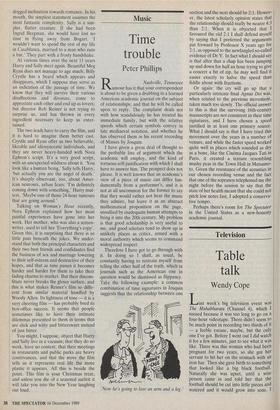Music
Time trouble
Peter Phillips
RNashville, Tennessee
umour has it that your correspondent is about to be given a drubbing in a learned American academic journal on the subject of relationships; and that he will be called upon to reply. The complaint deals not with how scandalously he has treated his immediate family, but with the relative speeds which certain symbols convey in late mediaeval notation, and whether he has observed them in his recent recording of Masses by Josquin.
I have given a great deal of thought to the probable line of argument which the academic will employ, and the kind of tortuous self-justification with which I shall have to answer him. The prospect doe' s not please. It is well known that an academic's view of a piece of music can differ fun- damentally from a performer's, and it is not at all uncommon for the former to say that they would rather not hear the music they admire, but leave it as an abstract mathematical proposition on the page, unsullied by inadequate human attempts to bring it into the 20th century. My problem is that good scholarship is very useful to me, and good scholars tend to show up in unlikely places as critics, armed with a moral authority which seems to command widespread respect.
Therefore I have got to go through with it. In doing so I shall, as usual, be constantly having to restrain myself from telling the other half of the truth, which in journals such as the American one in question would be dismissed as flippancy. Take the following example: a common combination of time signatures in Josquin suggests that the relationship between one `Now he's going to lose an arm and a leg.' section and the next should be 2:1. Howev- er, the latest scholarly opinion states that the relationship should really be nearer 4:3 than 2:1. When it is objected that I favoured the old 2:1 I shall defend myself by saying that I preferred the arguments put forward by Professor X years ago for 2:1, as opposed to the newfangled so-called evidence of Dr Y. In fact what I should say is that after that a chap has been jumping up and down for half an hour trying to give a concert a bit of zip, he may well find it easier exactly to halve the speed than fiddle about with fractions.
Or again: the cry will go up that a particularly intricate final Agnus Dei was, when related to the previous movement, taken much too slowly. The official answer to this is that the surviving 16th-century manuscripts are not consistent in their time signatures, and I have chosen a speed justified in at least one primary source. What I should say is that I have tried this movement over the years in a number of Venues, and while the faster speed worked quite well in places which sounded as dry as a bone, like the Cinema Jacques Tati in Paris, it created a texture resembling mushy peas in the Town Hall in Matsumo- to. Given the resonance of the acoustics in our chosen recording venue and the fact that one of the sopranos telephoned me the night before the session to say that the state of her health meant that she could not pitch low notes fast, I adopted a conserva- tive tempo.
Perhaps there's room for The Spectator in the United States as a new-honesty academic journal.


















































 Previous page
Previous page